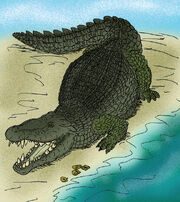Deinosuchus is an extinct relative of the alligator that lived 80 to 73 Ma (million years ago), during the Late Cretaceous period.The first remains were discovered in North Carolina in the 1850s, but it was not until 1909 that the genus was named and described. Additional fragments were discovered in the 1940s and were later incorporated into an influential, though inaccurate, skull reconstruction at the American Museum of Natural History. Knowledge of Deinosuchus remains incomplete, but better cranial material found in recent years has expanded scientific understanding of this massive predator.

Deinosuchus 1
Although Deinosuchus was far larger than any modern crocodile or alligator—measuring up to 12 m (40 ft) and weighing up to 8.5 metric tons (9.4 short tons)—its overall appearance was fairly similar to its smaller relatives. It had large, robust teeth that were built for crushing, and its back was covered with thick semispherical osteoderms. One study indicates that Deinosuchus may have lived for up to 50 years, growing at a similar rate to that of modern crocodilians, but maintaining this growth over a much longer period of time.
Deinosuchus fossils have been found in ten U.S. states, as well as northern Mexico. It lived on both sides of the Western Interior Seaway, and was an opportunistic apex predator in the coastal regions of eastern North America. Deinosuchus reached its largest size in its western habitat, but the eastern populations were far more abundant. Opinion remains divided as to whether these two populations represent separate species. Deinosuchus was probably capable of killing and eating large dinosaurs. It may have also fed upon sea turtles, fish, and other aquatic and terrestrial prey.